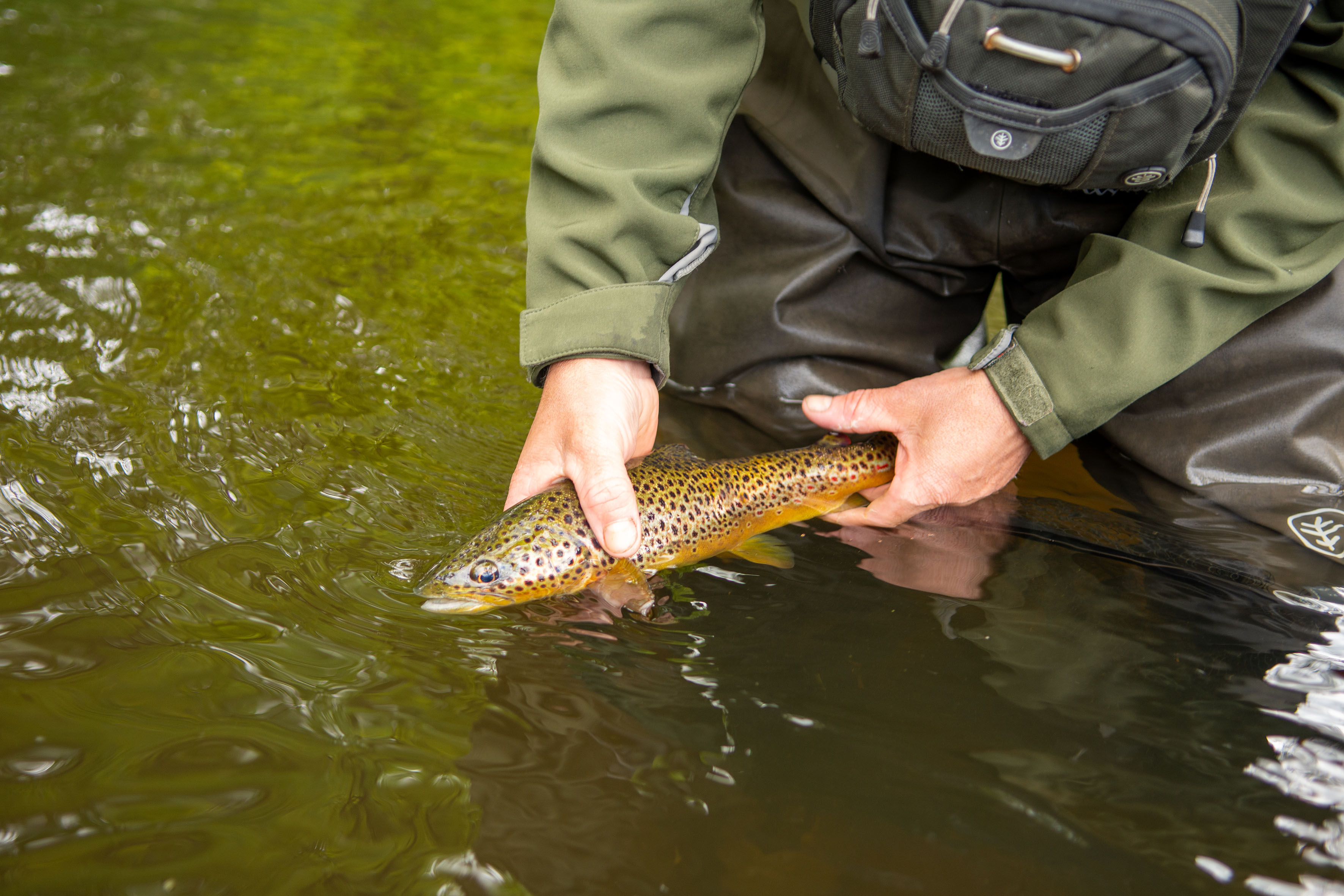Words by Geoff Hadley
Photos by Thomas Finney
Back in the second week of May 2022 I made the trip over to Derbyshire to meet up with Wychwood’s Thomas Finney to fish the famous Peacock at Rowsley Fly Fishing Club’s waters, shoot some content for Wychwood Game, and hopefully catch a few wild trout into the bargain.
We met on the car park of the Peacock Hotel, under a sky filled with hunting swifts (some of which were nesting in the rooves of the hotel and other nearby buildings) and, after a quick chat with river keeper Jan Hobot and a couple of hotel guests who noticed our gear and couldn’t resist stopping for a few words, we donned our Wychwood Gorge SDS waders and made off for the short walk to the river…
The Derbyshire rivers had been slow to wake up that year. Insect hatches had been relatively sparse compared to previous seasons, probably due to the low temperatures and high winds we’d had, so the wild brown and rainbow trout hadn’t yet been coming to the dry fly tactics these waters are famous for in any numbers.
The rivers Wye, Lathkill, and Bradford are famously “Dry Fly Only” during trout season but no such rule applies to the Derwent and, armed with the knowledge that several good fish had been taken by club members using sub-surface tactics in the last few days, it was to the Derwent we headed now.
I’d left Staffordshire in warm sun and light winds but, 35 miles east and a little north, the wind was cold, would prove to be rattling downstream, and the skies were a leaden grey that threatened rain.
Tom and I made our way across the road and through the meadow, with me pointing out various wildflowers, birds (chiffchaff, willow warbler, dipper, kingfisher and mandarin duck) and other wildlife as we went, on a rough path that leads towards the point where the river Wye makes it’s confluence with the Derwent. It’s a spot I know quite well and it’s usually good for a fish or two on whatever technique takes your fancy and sometimes holds fish of larger proportions than average.
I took to the water, a 10 foot 3wt Drift rod in hand, matched with a River and Stream reel, River Nympher line and a couple of nymphs on a French style tapered leader, while Tom made himself comfortable up the bank and snapped away with his camera. Half an hour later and with just a couple of half-hearted nips to my name, the first seeds of doubt were starting to germinate in my mind...
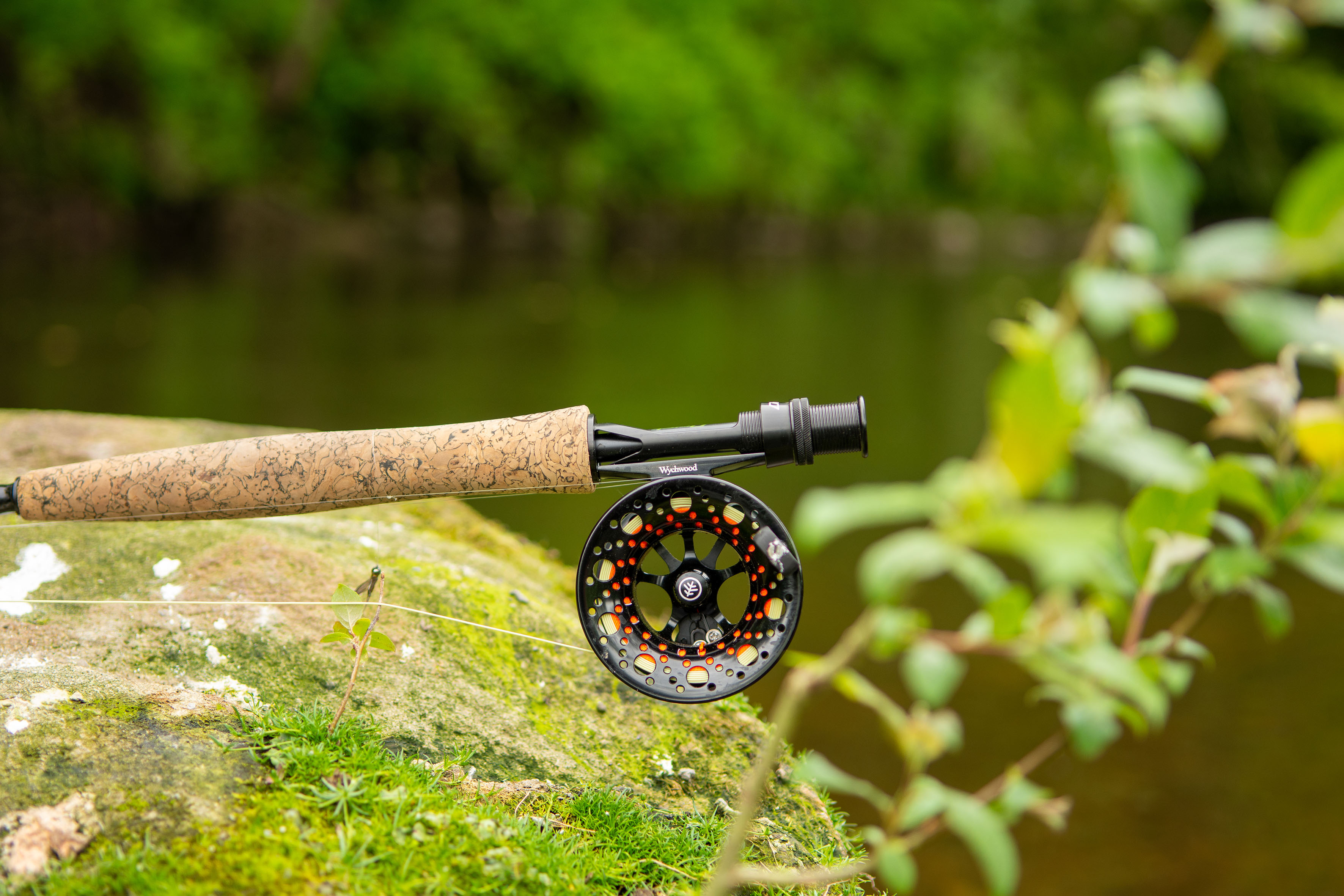
We upped sticks and moved to a spot upstream where I’d narrowly missed a very good fish a couple of weeks beforehand. I had a score to settle here but after a few casts it became obvious that the fish either wasn’t at home or wasn’t in the mood to feed. To be honest, I couldn’t blame it. The cold wind and grey skies had fulfilled their promise of rain and a steady drizzle filled the air. The water around my waders and on my flies and leader was much colder than I might’ve expected and the combination of weather and water conditions was evidently affecting the invertebrate life as well as the trout as we’d seen almost no fly life coming off and, therefore, very few fish moving either. I could feel my usual optimism draining steadily away.

Still, I fished on. A cast here, a cast there, as we worked our way up the river. Nymphs in the runs and pockets and darker arts on slightly heavier tackle in the deeper holes and slacks and, as we approached a couple of pools that I really fancied the look of, it seemed to me that, just maybe, the sky had lightened and the temperature had risen a touch. Certainly, the rain had stopped, which was a blessed relief and, as I took to the water once again, to gain access to a deeper run under the far bank sycamores, I thought I saw a disturbance in a smooth glide a little upstream…
“Was that a rise?” I asked Tom, but he’d been watching my progress across the stream and hadn’t noticed. I stopped and scanned the run again but no further disturbance came and I turned my attention to another fruitless drift with the nymphs. As I worked my way upstream a dipper flew past and as I watched its passage Tom called out “I think that was a rise, Geoff!”
“Where?” I replied. “In that run just above you” returned Tom. The same run I’d seen the disturbance in on my way out. I stopped and focussed my attention upstream. The sky had lightened considerably in the last few minutes, pieces of blue now showed through the clouds and a brighter patch behind the clouds showed where the sun was doing its utmost to break through…
Sure enough, after a few of minutes of patient observation, there came the telltale show of circular ripple as a snout broke the surface of the water to take in some unfortunate morsel as it drifted downstream. I quickly waded back to Tom’s side of the river, swapped my nymph outfit for my favourite dry fly outfit (a 9ft 6inch Drift XL 4wt teamed with a Truefly SLA MK II reel and Featherdown Floater line) and worked my way back upstream and across towards the run the fish had risen in.
In the time it took me to trek across the river and back the fish rose three or four times and it wasn’t alone. The lift in temperature had obviously stirred the Derwent’s insect population into action. Gnats and midges now took to the air and to the water’s surface and were joined by a steady trickle of olives and sedges as well as a few yellow mayflies. As I closed on my target fish in the smooth run I noticed another regular riser in the small pool above it, a third just off the trailing branches of the sycamore upstream, and a fourth right in amongst the foliage. Tom chipped in that he could see even more rises further upstream beyond the tree and several rising downstream of me.
My dry fly leader was made with a 12ft, 4lb, Wychwood Camo Mode tapered leader, cut back slightly to accommodate 2ft of 0.14mm (4.4lb) and another 2ft of 0.12mm (3.4lb) Silk Mode tippet to make a full-length leader of around 15ft. This, I hoped, would be long enough to give drag free drifts but not too long to punch out into the downstream wind without tangling. To the end of the tippet, I tied a size 16 LTD sedge, a fly devised and shown to me by fellow Team Wychwood member and wild river maestro, Glen Pointon. It’s a really good “general fit” pattern and, when tied in different sizes, covers a whole host of insects from midges, through olives, to the sedges its name suggests. It’s a real confidence fly for me and I had no hesitation in casting it over the fish feeding in front of me.
Things didn’t quite go to plan (again!) first off. The trout in the smooth run rose again and I cast my fly into the run just above the dissipating ripples. I expected the trout to rise straight for my fly… but nothing happened. My sedge drifted, unmolested, over the trout’s lie and downstream. I whipped the fly off the water and sent it back into the run. Again, nothing. I cast four more times into that run and four more times I got no response; in fact, the fish never rose again. Not to my fly and not to any of the naturals that were now drifting regularly downstream. To say I was surprised would be an understatement. I can only think that I’d somehow disturbed the fish without realising it. I turned my attention to the next riser upstream…
This style of fishing is my absolute favourite. Stalking visible fish, wading, up to my middle in the river, trying to get as close as possible to the target without spooking it and presenting short, accurate casts to get the perfect drift (or as perfect as possible). The next fish I targeted took my fly on the first drift. A confident, no messing about rise saw me set the hook into a truly beautiful half pounder. After a spirited fight it succumbed to the net and Tom and I admired the black and red spots on its yellow-gold body and silver blue on the gill plate. A quick photo and the little brownie was released none the worse for our encounter. I was off the mark!
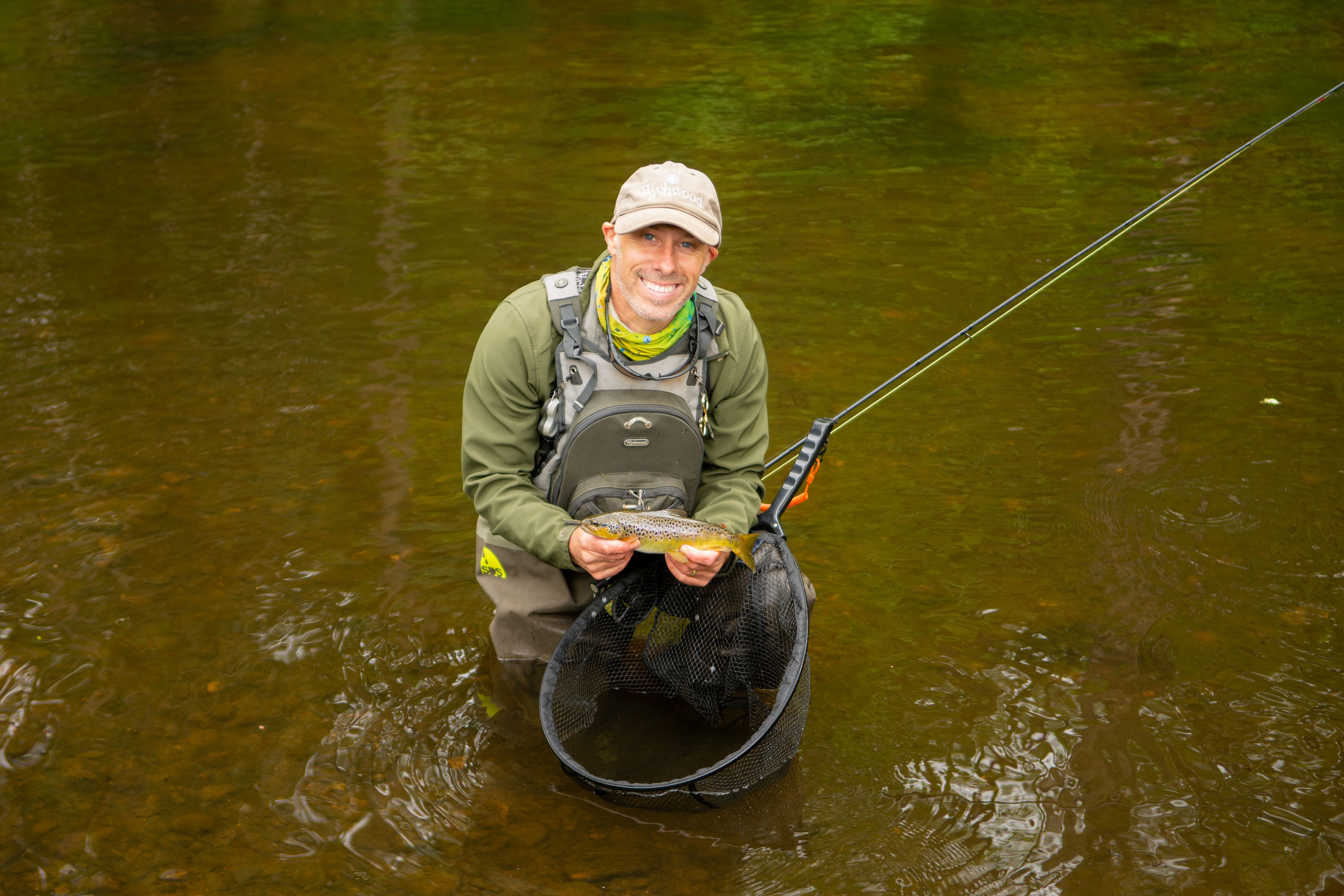
The rest of the day passed in similar fashion. One or other of us would spot a rise and I would work my way into position to present my fly while Tom snapped away from the bankside or from a position in the river. The Derwent’s brown trout were switched on and in a very obliging mood; the afternoon couldn’t have been more of a contrast to the dreary morning. I picked off trout after glorious trout, most around the eight to twelve ounce mark, and two or three from very tricky lies (I even managed to get the one from under branches of that overhanging sycamore, after several less than perfect casts!) all on the LTD (Living The Dream) sedge.
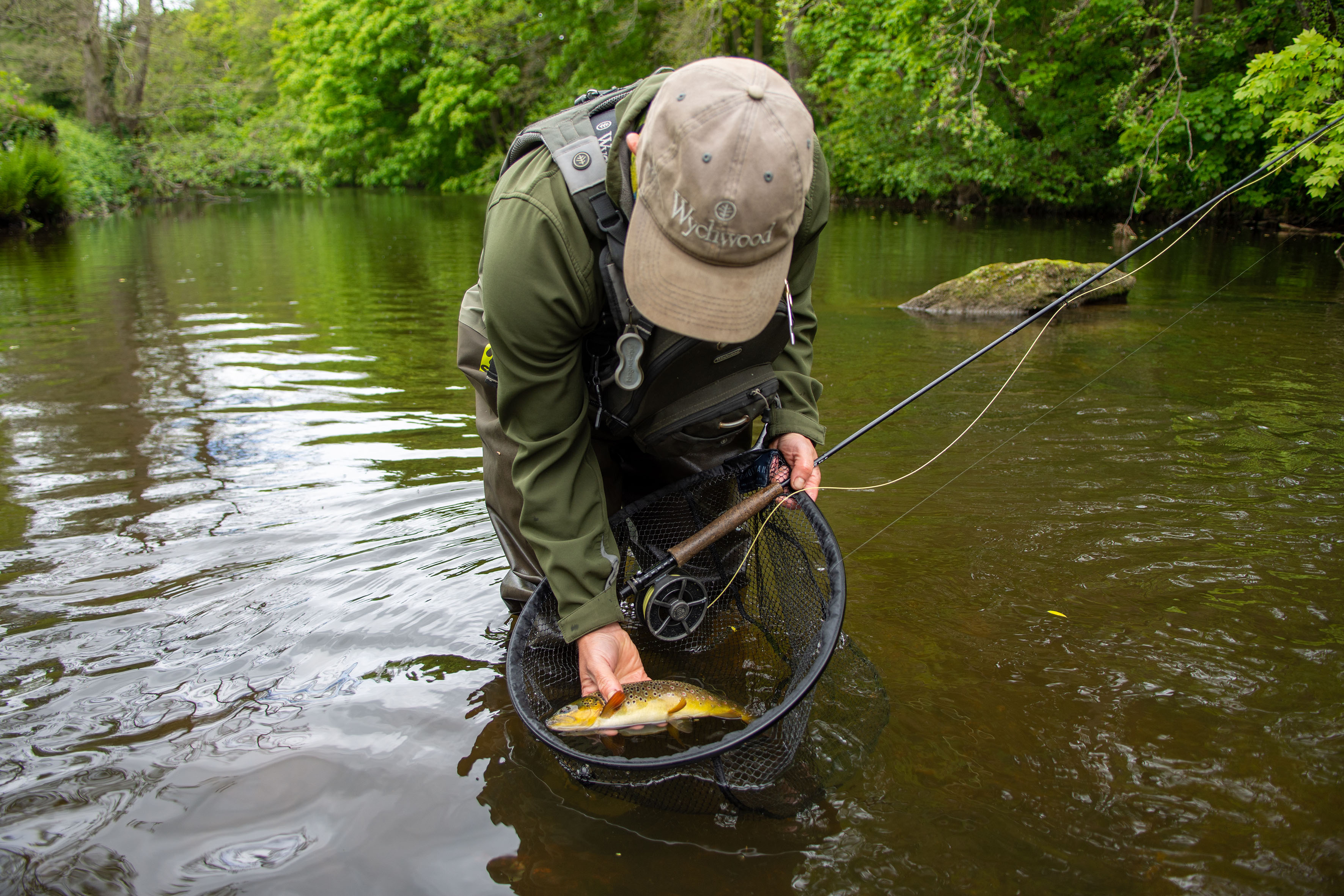
A couple of larger fish also gifted and delighted us with their presence. Having spotted a rise in a long straight that ran about 30 yards between two big old sycamore trees, I’d left Tom on the bank to look through some of the photos he’d taken. As I made my way up towards the rise forms, I discovered the shallow gravels I was walking on, about a third of the way across the river, suddenly dropped away at the front of a large boulder. Searching around through my polarising sunglasses and poking with the tip of my rod I realised I couldn’t get anywhere near as close to my intended quarry as I’d like.
The fish was, however, still rising readily and, having worked my way this far I was reluctant to give up without at least trying a cast. After pulling several more yards of line off my reel I prepared to put a long cast upstream and towards about the two o’clock position. The fish was sitting well away from any cover that I could see and I thought it might just be one of the wild rainbows that these Derbyshire rivers are famous for. As I waited for a lull in the downstream wind the fish continued to make its subtle rises, sipping morsels off the surface film and never moving more than a few feet from where I’d first seen it.
After several minutes the breeze dropped and I sent out my fly. It dropped into the run and began to drift back towards me. After only about four seconds that subtle rise form came again and my fly disappeared into the gentle ripples. I lifted sharply, expecting to feel the zip and thrum of another half pounder, and got a hell of a shock when my rod hooped over then hooped over even more! A large boil spread across the rivers surface, my rod bucked and line streamed through my left hand as the fish pulled hard upstream and for the far bank. My reel sang as the ever-reliable drag of the SLA MKII gave line and another boil heaved at the surface as the trout bucked and twisted against the pressure.
For a couple of moments, I thought the fish might yield easily, as it came back downstream towards me, but then it came to its senses and dived away downstream past me, revealing itself, not as a rainbow, but as a very decent Derwent brown. Rather than give more line I elected to follow it downstream back towards where I’d left Tom, who had noticed the disturbance and was now getting into position for some more action shots.
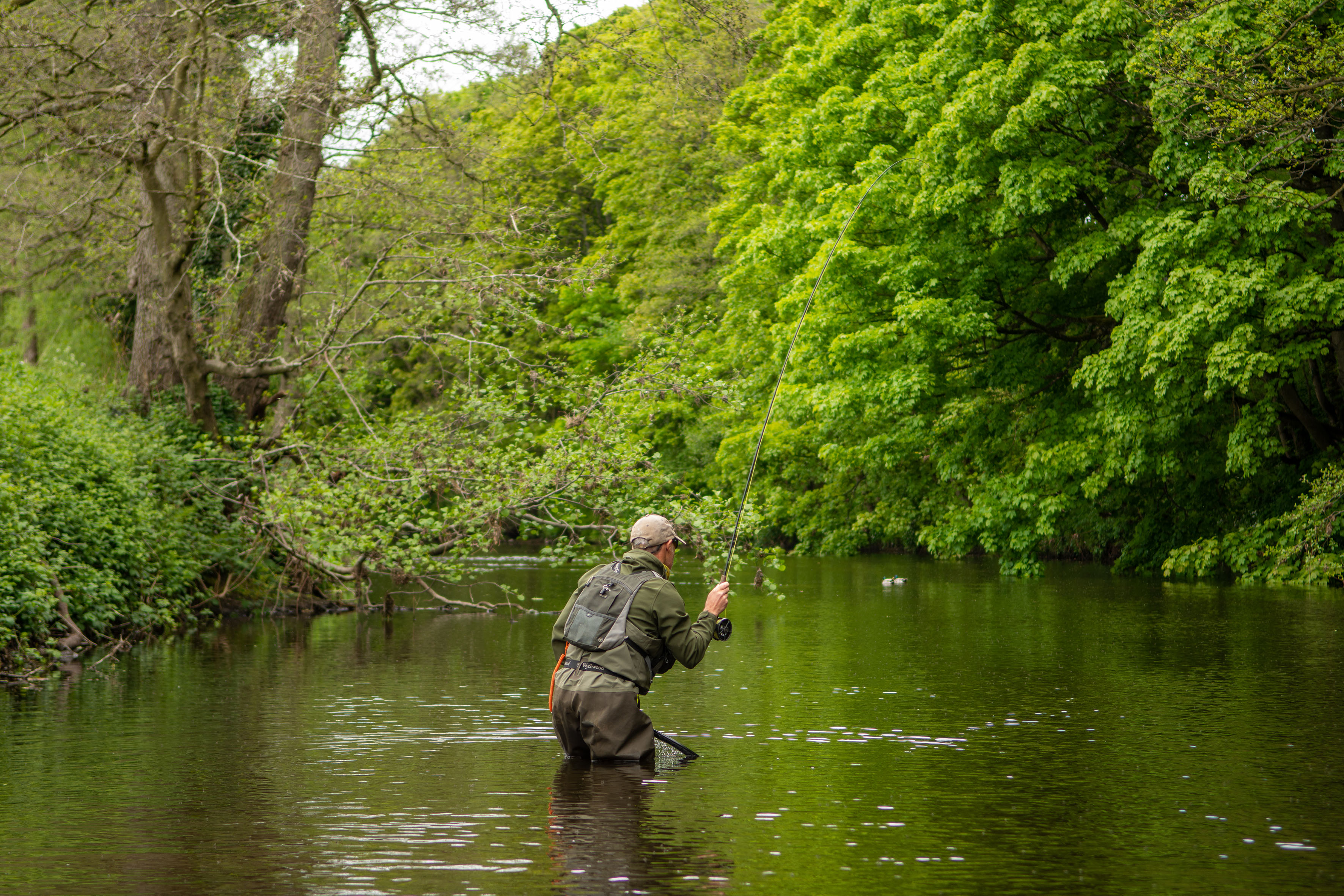
The fish’s downstream charge seemed to use up the last of it’s energy and as I caught up with it, it began to wallow and allowed itself to be drawn into the folds of my Wychwood Brookman net. At a little over two pounds, with yellow gold flanks and bright red spots, the fish was one of the best I’ve ever taken from the Derwent and proved to be the largest of the day; the best, however, was to come a little later on…

Understandably, after all the commotion, things went rather quiet in that section of the river so Tom and I upped sticks and took a wander back into the meadow. With plenty of shots in the can we were giving some thought to calling it a day when I spotted another rise over towards the far bank.
The river here was shallow on the near side, deepening off around half way with a push of current towards the far bank. The fish was rising regularly in, or just off, a back eddy between a large sycamore which spread its boughs across the far quarter of the river and an old dead tree trunk that stuck out at an angle into the flow, pushing the current out from that bank and speeding it up below the eddy. It would be a tricky spot to get a decent, drag free, drift but experience told me that fish sitting in spots like this are often good ones, so I decided to give it a go.
It took me a good half hour to get into a position I was happy with to make a cast. The fish continued to rise regularly and I was confident that my fly would be taken as long as I could get into the fish’s window. I’d changed my fly three or four times during the session but only when it had got too bedraggled to float and I’d stuck to the same pattern, the LTD sedge taking almost every fish I’d thrown it at.

Casting now, about 50 feet upstream, I put a wiggle into my cast to allow some more slack and hopefully reduce any drag on the fly. The sedge drifted into the trout’s window and the fish made straight for it… before turning away and returning to its station. I was stunned! I cast again and got the same result. On the third cast, after a short wait, the fish just ignored my fly completely. Time for a rethink.
I was pretty sure I’d got the drift right so the issue must be my fly. I tried a smaller LTD sedge. The fish again inspected then dismissed my fly. I tried a larger one but the trout didn’t even move to inspect it. A Griffith’s gnat was similarly ignored, but the trout continued to rise confidently to some sort of natural. I tried two or three olive patterns in different colours and sizes but the fish refused to take them.
Just then something landed on my left hand. Instinctively I went to shake it off then caught sight of it and stopped myself. A small yellow mayfly clung to the back of my hand then fluttered it’s gossamer wings and took to the air. Could this be what my target was taking? I delved into my Wychwood Hook-Hold fly box and searched through the patterns I’d got in there. Now, I’ve been told by more than one experienced angler of the Derbyshire rivers that the trout here don’t eat yellow mays but having tried sedge, midge and olive patterns to no effect, I was willing to try something a bit different.
I selected a fly that I’d tied, just as a bit of fun, a couple of weeks earlier; a size 14 Tupp’s Indispensable variant with a golden olive dubbed body, pink thorax, and a CDC wing instead of the more usual hackle. It was probably the last fly in the box that I’d expected to tie on that day.
Having rested the swim for a few minutes I edged another yard upstream and sent out my cast more in hope than expectation. The fly landed, travelled for a yard towards the trout’s position and disappeared as the fish lifted it’s nose through the surface film to engulf it. My surprise was almost as great as when it ignored my fly on the first cast! I set the hook and the fish threw itself into the air! Where my previous fish had fought deep with long runs this one fought with aerobatics up on the surface, leaping time and time again, running me in a complete circle in the middle of the river before it succumbed to the net.
I didn’t realise until afterwards that Tom had worked his way below me on the bank and had set up position through the V trunks of a big old elder. He’d managed to capture the whole fight from his position; from drift, to strike, to fight, and finally as the fish came to the net. The sequence is probably my favourite set of photos of me fishing ever!

.jpg)
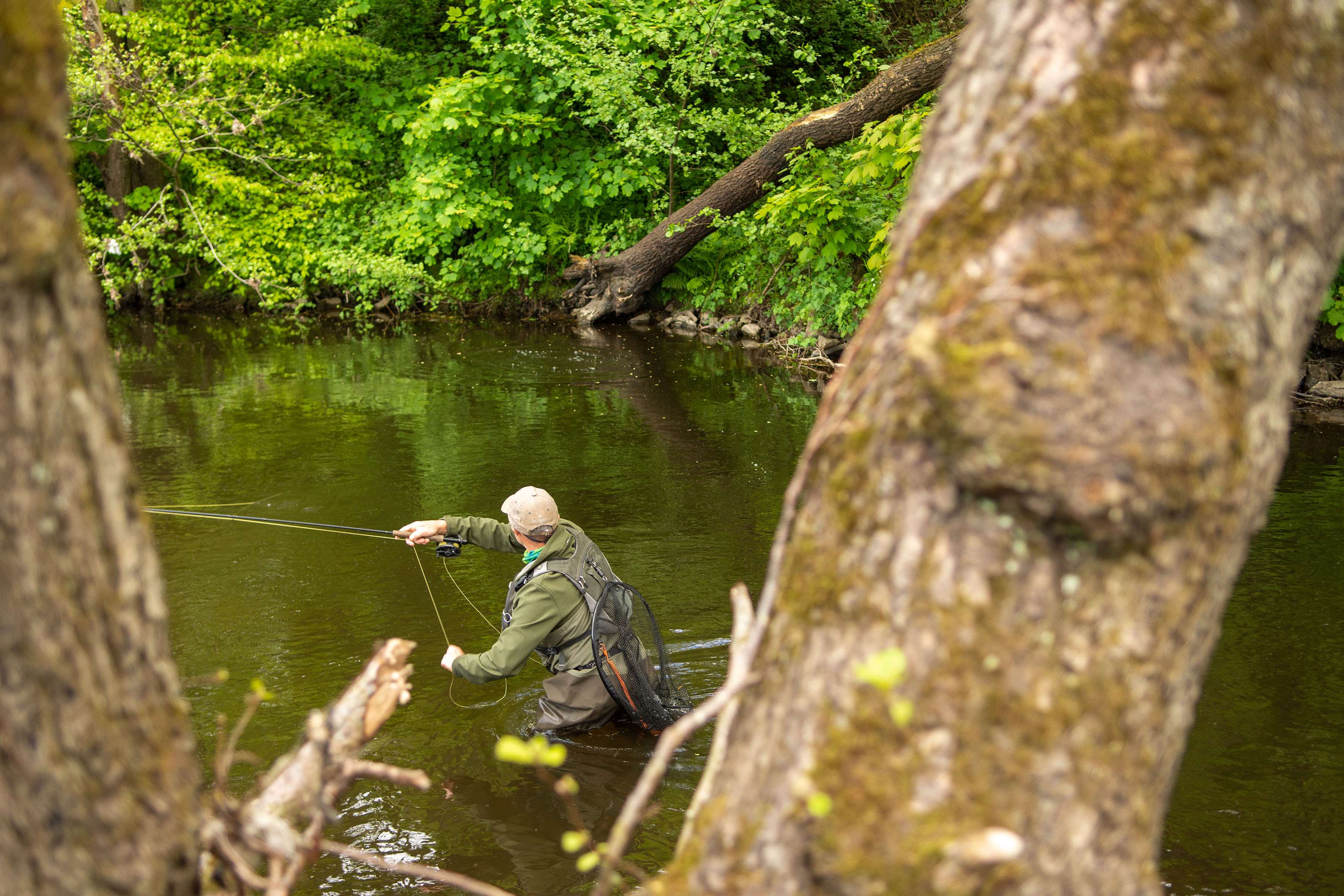
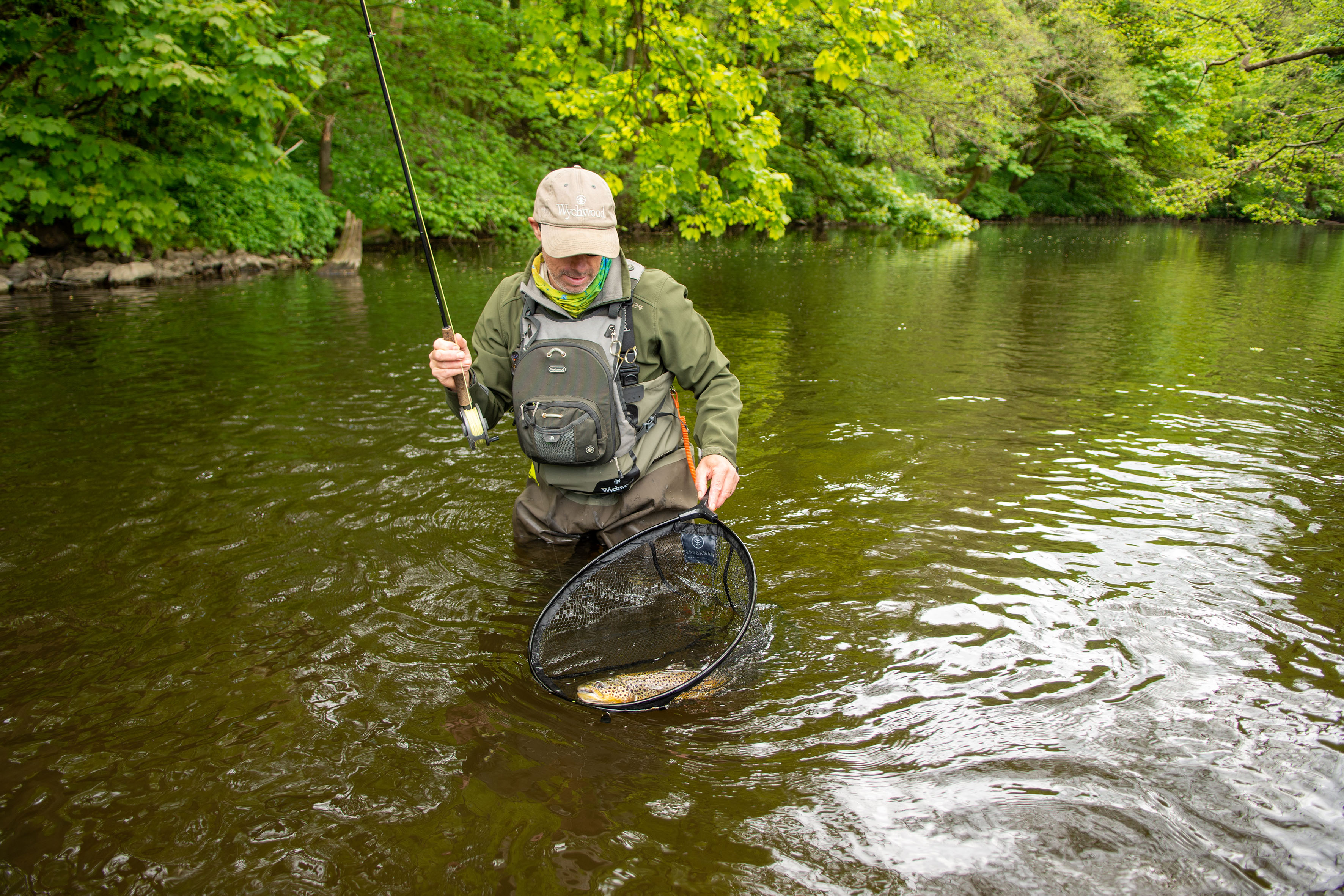
This trout was nothing short of spectacular! It’s body was more bronze than gold, was almost entirely patterned in black spots, with just a hint of red or orange here and there, and the tail and adipose were blood red. It wasn’t quite as big as the earlier fish but I couldn’t have cared less. It’s looks and the manner of its capture made this a very special trout indeed!
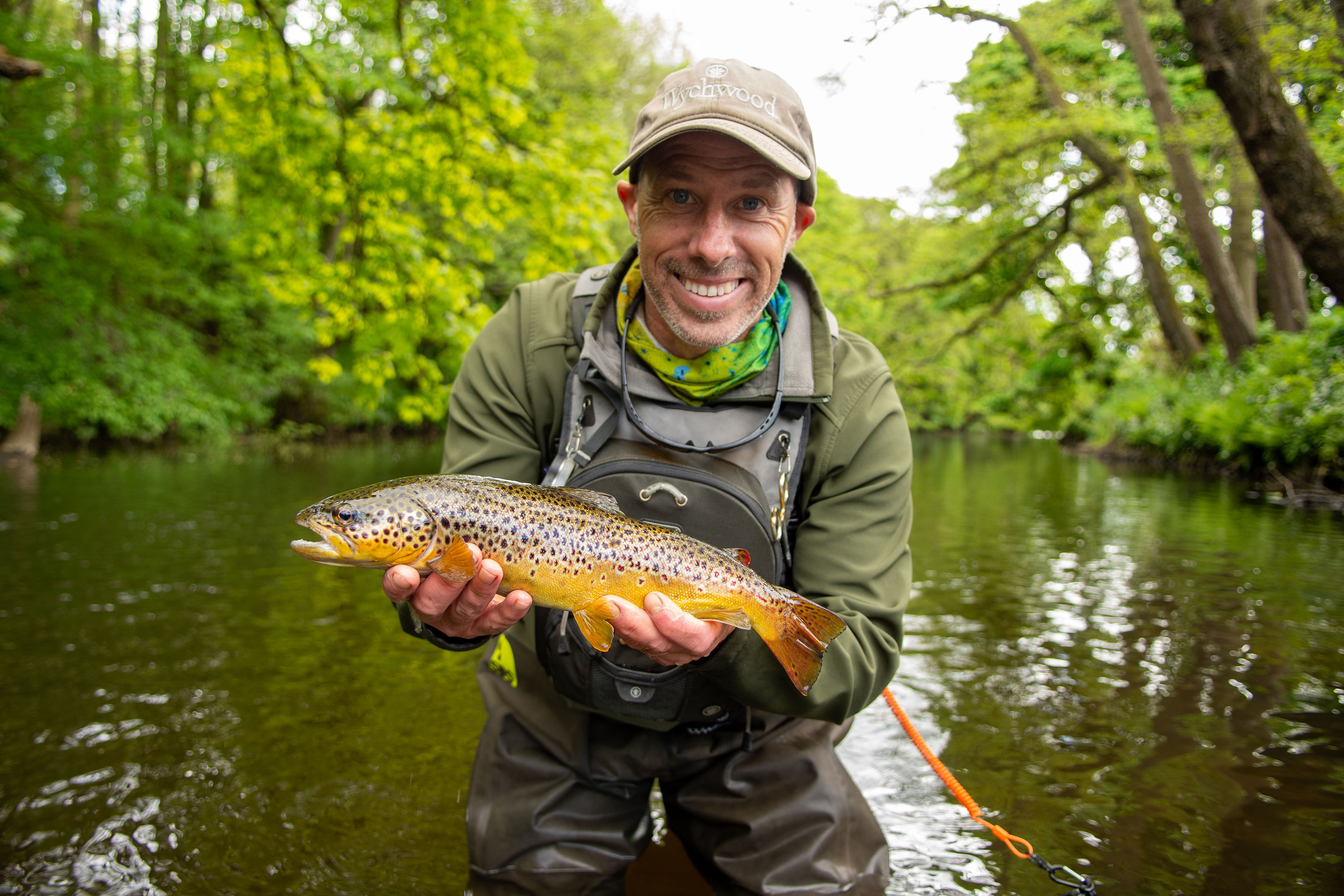
Our day couldn’t have got any better than that so Tom and I called it a wrap and headed back to our cars at The Peacock Hotel. Above us the swifts still hawked and hunted, building their nests and feeding their young. Beyond the hotel’s grounds, in the waters of the river Derwent, trout, brown and wild rainbow, rose to midges, sedges and olives; and one or two to yellow mayfly…
The waters of the Peacock at Rowsley Fly Fishing Club are very special indeed. It is a privilege to be able to fish them and one that I will never take for granted. My thanks go to Jan Hobot for his hard work and dedication to the rivers and wildlife of the Haddon Estate for without him and his team this adventure, and many others, would not be possible.
